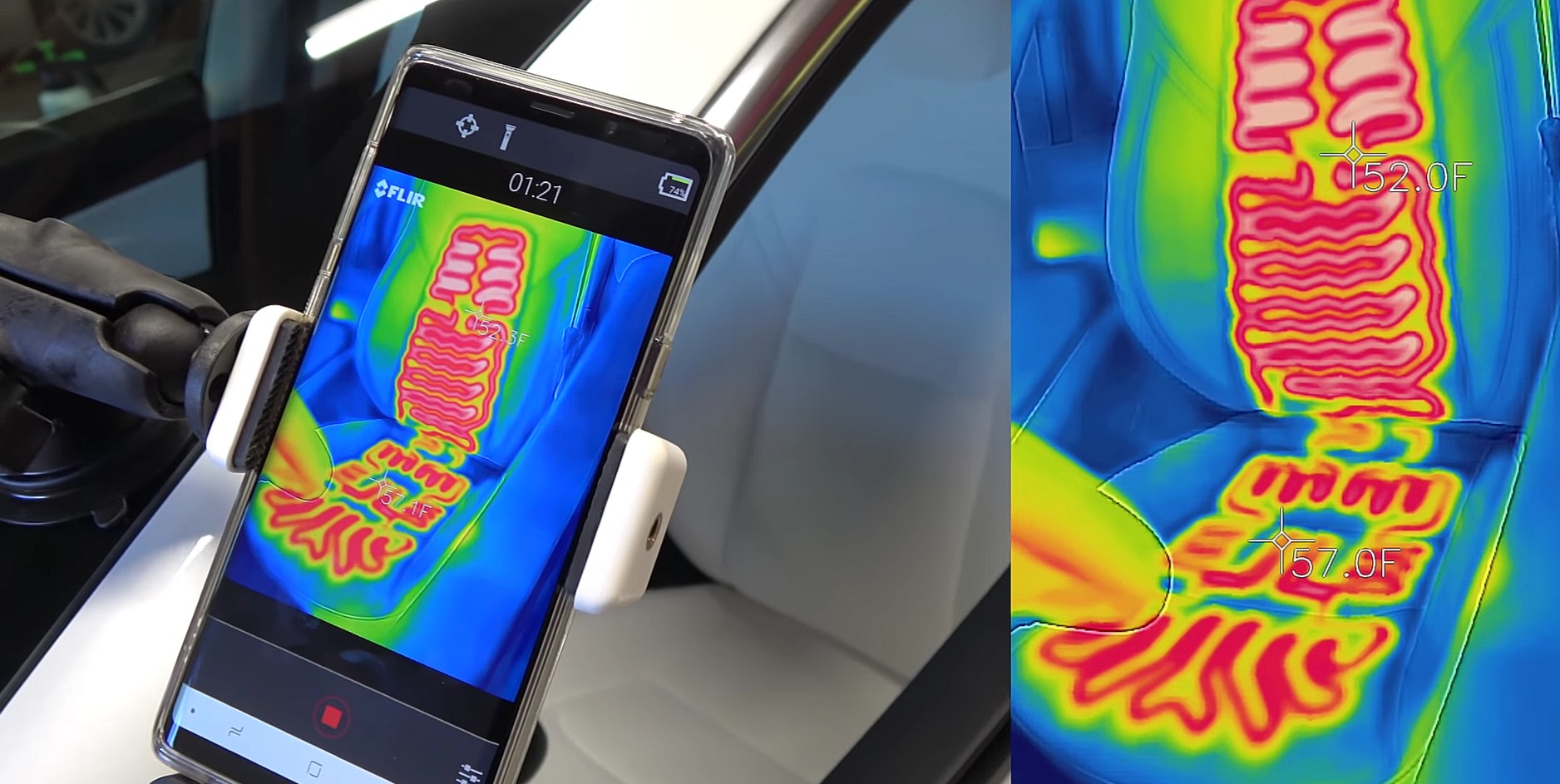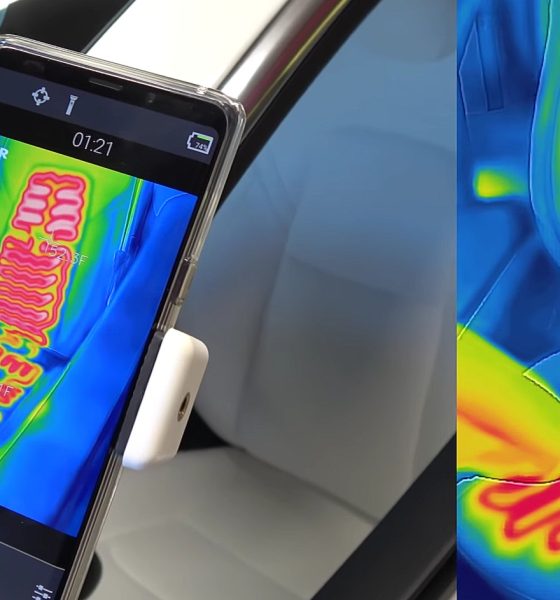

News
Tesla Model 3 and Model S heated seats compared in temperature test showdown
One of the best things about Tesla’s vehicles is their capability to improve over time. Through over-the-air updates, Tesla’s electric cars receive safety enhancements, fun Easter Eggs, new convenience features, and even additional driver-assist capabilities free of charge. These improvements have been particularly notable in the Model 3, as the vehicle has progressively gotten better since it started rolling off the assembly line back in July 2017.
The Tesla Model 3 is the company’s most affordable vehicle today, with its range-topping Performance variant costing less than a Model S 100D. Since it was released, several improvements to the vehicle have been rolled out, from shorter braking distances (courtesy of Consumer Reports) to rear seat warmers. In the case of the latter, the warmers were even a point of discussion among Tesla owners prior to their activation, considering that the feature was absent on the vehicle when it was initially delivered to reservation holders.
By March last year, though, Tesla introduced heated rear seats for the Model 3, making the feature universal for all the cars in its lineup. Last December, Tesla released an update that made seat heating even more convenient, allowing owners to activate and set their vehicles’ seat warmers from the mobile app. For the company’s flagship cars — the Model S and Model X — even the steering wheel heaters could be activated from the Tesla app.
Inasmuch as the heated seats of the Model 3 are a welcome feature, though, it is still quite interesting to see how it stacks up against the excellent seat heaters in the more premium, albeit older, Model S. Having both cars, Tesla owner-enthusiast Erik Strait opted to conduct a test to compare the Model 3 and Model S’ seat heaters using a FLIR thermal camera. Needless to say, the test results were quite compelling.
As could be seen in the video, the Model 3’s heaters actually work well. Five minutes after activating the feature on the app, the Model 3’s seat heaters registered 73.3 degrees Fahrenheit on the back and 81.5 F on the bottom. That’s not too far from the Model S, which registered 69.2 degrees Fahrenheit on the back and 84.6 F at the bottom after 5 minutes of activation.
That said, the Model S’ heaters appear to have an advantage over the Model 3, thanks to the distribution of heat on the seat itself. The Model 3’s seat heater is pretty straightforward, with the changes in temperature being centered on the areas directly above the heating element. Thus, while the center portions of the seat warmed up well, other portions such as the sides remained noticeably cooler. The Model S’s heating element, on the other hand, appeared to be well-distributed, resulting in a more even temperature across the entire seat.
There would be more improvements coming to the Model 3 and Model S in the coming months. In the case of the flagship sedan, speculations are high that Tesla might update the vehicles’ batteries to newer, larger 2170 cells, which the company is using for the Model 3. With 2170 cells and more advanced cooling systems, the Model S would be even more impressive than it is today, despite being a benchmark for premium electric vehicles for years.
Watch Erik’s comparison of the Tesla Model 3 and the Model S’ seat heaters in the video below.

Elon Musk
Elon Musk and Tesla AI Director share insights after empty driver seat Robotaxi rides
The executives’ unoccupied tests hint at the rapid progress of Tesla’s unsupervised Robotaxi efforts.

Tesla CEO Elon Musk and AI Director Ashok Elluswamy celebrated Christmas Eve by sharing personal experiences with Robotaxi vehicles that had no safety monitor or occupant in the driver’s seat. Musk described the system’s “perfect driving” around Austin, while Elluswamy posted video from the back seat, calling it “an amazing experience.”
The executives’ unoccupied tests hint at the rapid progress of Tesla’s unsupervised Robotaxi efforts.
Elon and Ashok’s firsthand Robotaxi insights
Prior to Musk and the Tesla AI Director’s posts, sightings of unmanned Teslas navigating public roads were widely shared on social media. One such vehicle was spotted in Austin, Texas, which Elon Musk acknowleged by stating that “Testing is underway with no occupants in the car.”
Based on his Christmas Eve post, Musk seemed to have tested an unmanned Tesla himself. “A Tesla with no safety monitor in the car and me sitting in the passenger seat took me all around Austin on Sunday with perfect driving,” Musk wrote in his post.
Elluswamy responded with a 2-minute video showing himself in the rear of an unmanned Tesla. The video featured the vehicle’s empty front seats, as well as its smooth handling through real-world traffic. He captioned his video with the words, “It’s an amazing experience!”
Towards Unsupervised operations
During an xAI Hackathon earlier this month, Elon Musk mentioned that Tesla owed be removing Safety Monitors from its Robotaxis in Austin in just three weeks. “Unsupervised is pretty much solved at this point. So there will be Tesla Robotaxis operating in Austin with no one in them. Not even anyone in the passenger seat in about three weeks,” he said. Musk echoed similar estimates at the 2025 Annual Shareholder Meeting and the Q3 2025 earnings call.
Considering the insights that were posted Musk and Elluswamy, it does appear that Tesla is working hard towards operating its Robotaxis with no safety monitors. This is quite impressive considering that the service was launched just earlier this year.
Elon Musk
Starlink passes 9 million active customers just weeks after hitting 8 million
The milestone highlights the accelerating growth of Starlink, which has now been adding over 20,000 new users per day.

SpaceX’s Starlink satellite internet service has continued its rapid global expansion, surpassing 9 million active customers just weeks after crossing the 8 million mark.
The milestone highlights the accelerating growth of Starlink, which has now been adding over 20,000 new users per day.
9 million customers
In a post on X, SpaceX stated that Starlink now serves over 9 million active users across 155 countries, territories, and markets. The company reached 8 million customers in early November, meaning it added roughly 1 million subscribers in under seven weeks, or about 21,275 new users on average per day.
“Starlink is connecting more than 9M active customers with high-speed internet across 155 countries, territories, and many other markets,” Starlink wrote in a post on its official X account. SpaceX President Gwynne Shotwell also celebrated the milestone on X. “A huge thank you to all of our customers and congrats to the Starlink team for such an incredible product,” she wrote.
That growth rate reflects both rising demand for broadband in underserved regions and Starlink’s expanding satellite constellation, which now includes more than 9,000 low-Earth-orbit satellites designed to deliver high-speed, low-latency internet worldwide.
Starlink’s momentum
Starlink’s momentum has been building up. SpaceX reported 4.6 million Starlink customers in December 2024, followed by 7 million by August 2025, and 8 million customers in November. Independent data also suggests Starlink usage is rising sharply, with Cloudflare reporting that global web traffic from Starlink users more than doubled in 2025, as noted in an Insider report.
Starlink’s momentum is increasingly tied to SpaceX’s broader financial outlook. Elon Musk has said the satellite network is “by far” the company’s largest revenue driver, and reports suggest SpaceX may be positioning itself for an initial public offering as soon as next year, with valuations estimated as high as $1.5 trillion. Musk has also suggested in the past that Starlink could have its own IPO in the future.
News
NVIDIA Director of Robotics: Tesla FSD v14 is the first AI to pass the “Physical Turing Test”
After testing FSD v14, Fan stated that his experience with FSD felt magical at first, but it soon started to feel like a routine.

NVIDIA Director of Robotics Jim Fan has praised Tesla’s Full Self-Driving (Supervised) v14 as the first AI to pass what he described as a “Physical Turing Test.”
After testing FSD v14, Fan stated that his experience with FSD felt magical at first, but it soon started to feel like a routine. And just like smartphones today, removing it now would “actively hurt.”
Jim Fan’s hands-on FSD v14 impressions
Fan, a leading researcher in embodied AI who is currently solving Physical AI at NVIDIA and spearheading the company’s Project GR00T initiative, noted that he actually was late to the Tesla game. He was, however, one of the first to try out FSD v14.
“I was very late to own a Tesla but among the earliest to try out FSD v14. It’s perhaps the first time I experience an AI that passes the Physical Turing Test: after a long day at work, you press a button, lay back, and couldn’t tell if a neural net or a human drove you home,” Fan wrote in a post on X.
Fan added: “Despite knowing exactly how robot learning works, I still find it magical watching the steering wheel turn by itself. First it feels surreal, next it becomes routine. Then, like the smartphone, taking it away actively hurts. This is how humanity gets rewired and glued to god-like technologies.”
The Physical Turing Test
The original Turing Test was conceived by Alan Turing in 1950, and it was aimed at determining if a machine could exhibit behavior that is equivalent to or indistinguishable from a human. By focusing on text-based conversations, the original Turing Test set a high bar for natural language processing and machine learning.
This test has been passed by today’s large language models. However, the capability to converse in a humanlike manner is a completely different challenge from performing real-world problem-solving or physical interactions. Thus, Fan introduced the Physical Turing Test, which challenges AI systems to demonstrate intelligence through physical actions.
Based on Fan’s comments, Tesla has demonstrated these intelligent physical actions with FSD v14. Elon Musk agreed with the NVIDIA executive, stating in a post on X that with FSD v14, “you can sense the sentience maturing.” Musk also praised Tesla AI, calling it the best “real-world AI” today.








